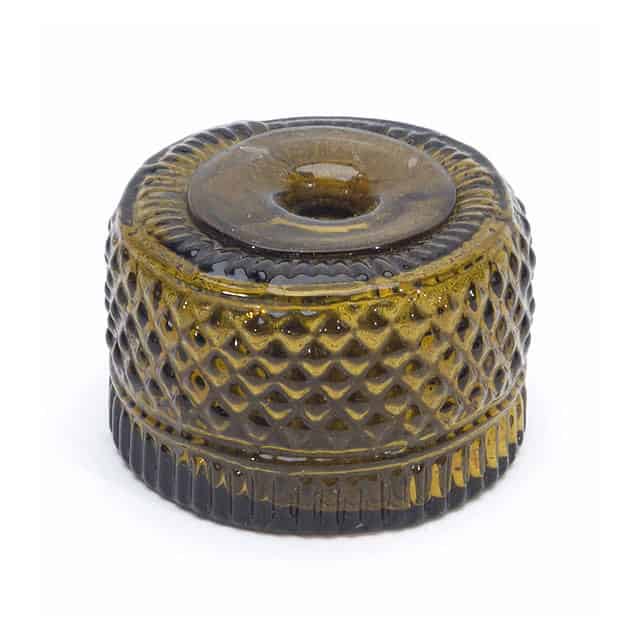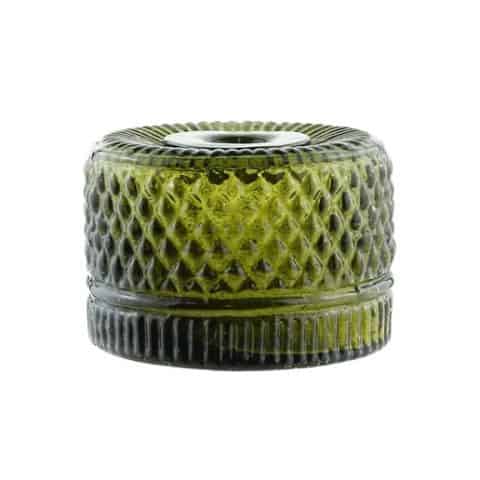GII-18e Coventry Inkwell
Blown Three Mold
Coventry Inkwell
GII – 18e
Coventry Glass Works, Coventry Connecticut
Blown Three Mold Geometric Inkwell
Medium Clear Green
Provenance: Richard S. Ciralli Collection

The Harry Hall White excavations on the site of Coventry Glass Works, in Coventry, Connecticut unearthed shards of many of the glassworks products which included the GII-18E three mold inkwells that were blown in geometric patterns consisting of a band of diamond diapering between bands of vertical ribbing.
After the War of 1812, American glass manufacturers began using molds as an inexpensive way to produce glassware similar in appearance to the much more expensive cut glass that was imported from Britain and Ireland. A dearth of skilled glassblowers may have also led to the increased use of molds. Blown molded glass was popular for about twenty years before it was superseded by pressed glass.

Our subject museum example is a GII-18E blown three mold Coventry inkwell that is 2″ tall with a 2-¾” base dimension. The inkwell has a concentric ring base, is pontiled, and is in a medium clear green glass. The inkwell was blown at Coventry Glass Works, Coventry, Connecticut circa 1825. The piece came from an old-time New England collection and was acquired in the distant past at a private “trade fest.” It is considered rare and the finest known example.

The main characteristic that sets apart three-mold ware from pressed glass is that the inverse of the pattern of three-mold glass can be felt on the inside of the object. Pressed glass is patterned only on the exterior and smooth inside. Pressed glass, termed “mold-pressed,” has an interior form independent of the exterior, in contrast to mold-blown glass, whose interior corresponds to the outer form. Plates, lamp bases, and doorknobs were usually made of pressed glass.
Primary Image: GII-18E Blown Three Mold Coventry Inkwell imaged on location by the FOHBC Virtual Museum midwest studio led by Alan DeMaison.
Support: Reference to American Bottles and Flasks and Their Ancestry by Helen McKearin and Kenneth M. Wilson, Crown Publishers Inc., New York, 1978.
Support: Reference to Ink Bottles and Inkwells, William F. Covill, Jr., 1971
Support: Reference to More News on “Connecticut Glass” by Rick Cirallli c/o RCGlass. The first in a series of exclusive articles for Bottles and Extras, Spring 2005
Support Images: Auction Lot 80: Blown Three Mold Inkwell, Coventry Glass Works, Coventry, Connecticut, 1820-1840. Cylindrical, brilliant olive-yellow, disc mouth – pontil scar, ht. 1 1/2 inches, dia. 2 3/8 inches. GII-18E Rare and beautiful color, one of the lightest we have seen. Fine condition. – Norman Heckler Jr. & Sr., Norman C. Heckler & Company
Support Images: Auction Lot 167: Blown Three Mold Inkwell, Coventry Glass Works, Coventry, Connecticut, 1820-1840. Cylindrical with concentric rings on base, deep yellow olive, tooled disc mouth – pontil scar, ht. 1 3/4 inches, dia. 2 5/8 inches; (two chips on disc mouth, the largest being 1/4 inch, potstone on side shows surface iridescence and several tiny “legs”). GII-18E A large example with a clean and mostly wear-free exterior surface. – Norman Heckler Jr. & Sr., Norman C. Heckler & Company, Auction #195
Support Image: Auction Lot 38: Blown Three Mold Inkwell, Mount Vernon Glass Works, Vernon, New York, 1820-1840. Cylindrical, deep olive amber, tooled disc mouth – pontil scar, ht. 1 11/16 inches, dia. 1 7/8 inches. GII-18A. A little sweetheart of an inkwell with no wear. Fine condition. Ex Ed Beaverstock collection. – Norman Heckler Jr. & Sr., Norman C. Heckler & Company, Auction #195
Support Image: Auction Lot 73: Blown Three Mold Inkwell, Keene Marlboro Street Glassworks, Keene, New Hampshire, 1820-1840. Cylindrical, deep cobalt blue, disc mouth – pontil scar, ht. 1 7/8 inches, dia. 2 1/16 inches; (shallow 1/4 inch flake from edge of base). GII-18B and C #1186 This is the exact example pictured in Covill’s text. Extremely rare and beautiful color. Generally fine condition. Alan Evanuk collection. – Norman Heckler Jr. & Sr., Norman C. Heckler & Company, Auction #167
Support Image: Auction Lot 173: Blown Three Mold Inkwell, Keene Marlboro Street Glassworks, Keene, New Hampshire, 1820-1840. Cylindrical with sixteen depressed rays on base, medium yellow olive, tooled disc mouth – pontil scar, ht. 1 3/4 inches, dia. 1 15/16 inches; (light exterior high point wear). GII-18C Appealing smaller size, beautiful color and strong mold impression. Fine condition. – Norman Heckler Jr. & Sr., Norman C. Heckler & Company, Auction #195
Join the FOHBC: The Virtual Museum is a project of the Federation of Historical Bottle Collectors (FOHBC). To become a member.






























